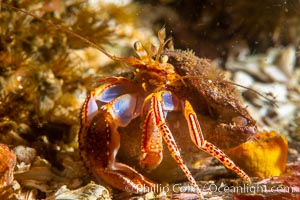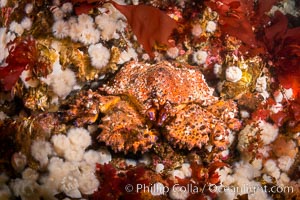
Lopholithodes mandtii Puget Sound King Crab amid a field of plumose anemones and red kelp, Queen Charlotte Strait, Canada.
Species: Puget sound king crab, Lopholithodes mandtii
Location: British Columbia, Canada
Image ID: 34348
Species: Puget sound king crab, Lopholithodes mandtii
Location: British Columbia, Canada
Image ID: 34348
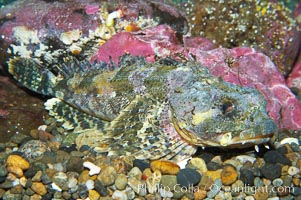
Red Irish Lord. The red irish lord lurks in shallow habitats where it feeds on crabs, shrimp, barnacles, mussels and small fishes.
Species: Red irish lord, Hemilepidotus hemilepidotus
Image ID: 13689
Species: Red irish lord, Hemilepidotus hemilepidotus
Image ID: 13689
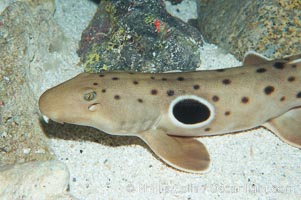
Epaulette shark. The epaulette shark is primarily nocturnal, hunting for crabs, worms and invertebrates by crawling across the bottom on its overlarge fins.
Species: Epaulette shark, Hemiscyllium ocellatum
Image ID: 14958
Species: Epaulette shark, Hemiscyllium ocellatum
Image ID: 14958
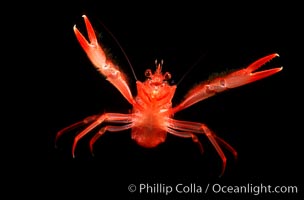
Pelagic red tuna crab, open ocean.
Species: Pelagic red crab, Pleuroncodes planipes
Location: San Diego, California
Image ID: 02247
Species: Pelagic red crab, Pleuroncodes planipes
Location: San Diego, California
Image ID: 02247
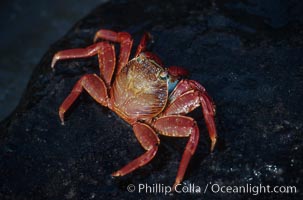
Sally Lightfoot crab.
Species: Sally lightfoot crab, Grapsus grapsus
Location: Galapagos Islands, Ecuador
Image ID: 01896
Species: Sally lightfoot crab, Grapsus grapsus
Location: Galapagos Islands, Ecuador
Image ID: 01896
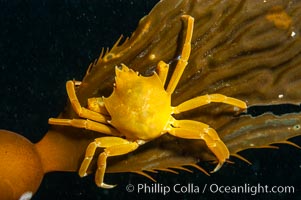
Northern kelp crab crawls amidst kelp blades and stipes, midway in the water column (below the surface, above the ocean bottom) in a giant kelp forest.
Species: Northern kelp crab, Macrocystis pyrifera, Pugettia producta
Location: San Nicholas Island, California
Image ID: 10218
Species: Northern kelp crab, Macrocystis pyrifera, Pugettia producta
Location: San Nicholas Island, California
Image ID: 10218
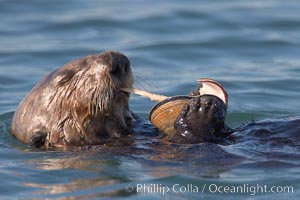
A sea otter eats a clam that it has taken from the shallow sandy bottom of Elkhorn Slough. Because sea otters have such a high metabolic rate, they eat up to 30% of their body weight each day in the form of clams, mussels, urchins, crabs and abalone. Sea otters are the only known tool-using marine mammal, using a stone or old shell to open the shells of their prey as they float on their backs.
Species: Sea otter, Enhydra lutris
Location: Elkhorn Slough National Estuarine Research Reserve, Moss Landing, California
Image ID: 21612
Species: Sea otter, Enhydra lutris
Location: Elkhorn Slough National Estuarine Research Reserve, Moss Landing, California
Image ID: 21612
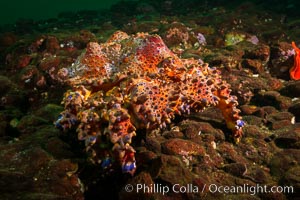
Lopholithodes mandtii, Puget Sound King Crab, Hornby Island, Canada.
Species: Puget sound king crab, Lopholithodes mandtii
Location: Hornby Island, British Columbia, Canada
Image ID: 32822
Species: Puget sound king crab, Lopholithodes mandtii
Location: Hornby Island, British Columbia, Canada
Image ID: 32822
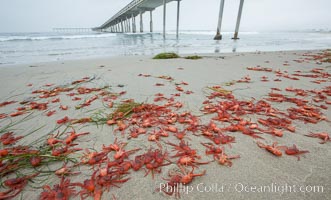
Pelagic red tuna crabs, washed ashore to form dense piles on the beach.
Species: Pelagic red crab, Pleuroncodes planipes
Location: Ocean Beach, California
Image ID: 30982
Species: Pelagic red crab, Pleuroncodes planipes
Location: Ocean Beach, California
Image ID: 30982
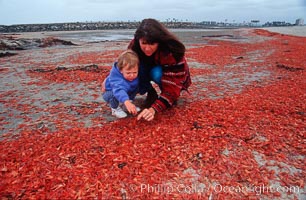
Pelagic red tuna crabs, washed ashore to form dense piles on the beach.
Species: Pelagic red crab, Pleuroncodes planipes
Location: Ocean Beach, California
Image ID: 06068
Species: Pelagic red crab, Pleuroncodes planipes
Location: Ocean Beach, California
Image ID: 06068
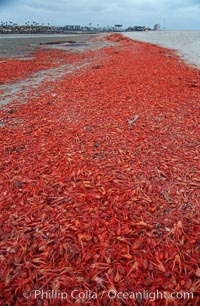
Pelagic red tuna crabs, washed ashore to form dense piles on the beach.
Species: Pelagic red crab, Pleuroncodes planipes
Location: Ocean Beach, California
Image ID: 06077
Species: Pelagic red crab, Pleuroncodes planipes
Location: Ocean Beach, California
Image ID: 06077
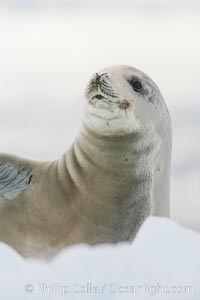
A crabeater seal, hauled out on pack ice to rest. Crabeater seals reach 2m and 200kg in size, with females being slightly larger than males. Crabeaters are the most abundant species of seal in the world, with as many as 75 million individuals. Despite its name, 80% the crabeater seal's diet consists of Antarctic krill. They have specially adapted teeth to strain the small krill from the water.
Species: Crabeater seal, Lobodon carcinophagus
Location: Neko Harbor, Antarctic Peninsula, Antarctica
Image ID: 25663
Species: Crabeater seal, Lobodon carcinophagus
Location: Neko Harbor, Antarctic Peninsula, Antarctica
Image ID: 25663
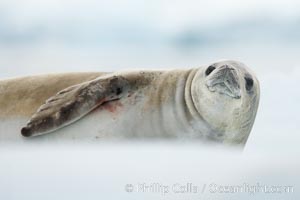
A crabeater seal, hauled out on pack ice to rest. Crabeater seals reach 2m and 200kg in size, with females being slightly larger than males. Crabeaters are the most abundant species of seal in the world, with as many as 75 million individuals. Despite its name, 80% the crabeater seal's diet consists of Antarctic krill. They have specially adapted teeth to strain the small krill from the water.
Species: Crabeater seal, Lobodon carcinophagus
Location: Neko Harbor, Antarctic Peninsula, Antarctica
Image ID: 25665
Species: Crabeater seal, Lobodon carcinophagus
Location: Neko Harbor, Antarctic Peninsula, Antarctica
Image ID: 25665
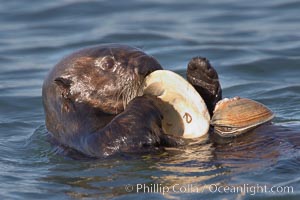
A sea otter eats a clam that it has taken from the shallow sandy bottom of Elkhorn Slough. Because sea otters have such a high metabolic rate, they eat up to 30% of their body weight each day in the form of clams, mussels, urchins, crabs and abalone. Sea otters are the only known tool-using marine mammal, using a stone or old shell to open the shells of their prey as they float on their backs.
Species: Sea otter, Enhydra lutris
Location: Elkhorn Slough National Estuarine Research Reserve, Moss Landing, California
Image ID: 21609
Species: Sea otter, Enhydra lutris
Location: Elkhorn Slough National Estuarine Research Reserve, Moss Landing, California
Image ID: 21609
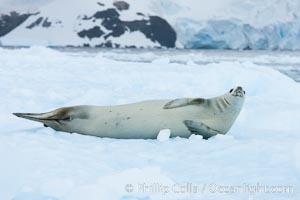
A crabeater seal, hauled out on pack ice to rest. Crabeater seals reach 2m and 200kg in size, with females being slightly larger than males. Crabeaters are the most abundant species of seal in the world, with as many as 75 million individuals. Despite its name, 80% the crabeater seal's diet consists of Antarctic krill. They have specially adapted teeth to strain the small krill from the water.
Species: Crabeater seal, Lobodon carcinophagus
Location: Cierva Cove, Antarctic Peninsula, Antarctica
Image ID: 25576
Species: Crabeater seal, Lobodon carcinophagus
Location: Cierva Cove, Antarctic Peninsula, Antarctica
Image ID: 25576
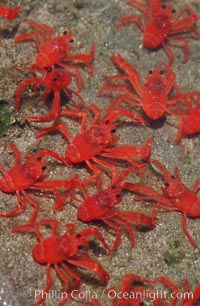
Pelagic red tuna crabs, washed ashore in tidepool.
Species: Pelagic red crab, Pleuroncodes planipes
Location: Ocean Beach, California
Image ID: 06062
Species: Pelagic red crab, Pleuroncodes planipes
Location: Ocean Beach, California
Image ID: 06062
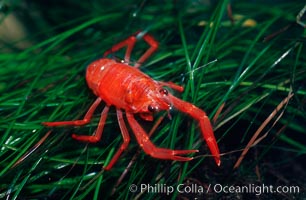
Pelagic red tuna crabs, washed ashore in tidepool.
Species: Pelagic red crab, Pleuroncodes planipes
Location: Ocean Beach, California
Image ID: 06065
Species: Pelagic red crab, Pleuroncodes planipes
Location: Ocean Beach, California
Image ID: 06065
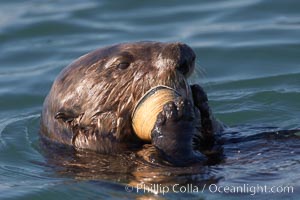
A sea otter eats a clam that it has taken from the shallow sandy bottom of Elkhorn Slough. Because sea otters have such a high metabolic rate, they eat up to 30% of their body weight each day in the form of clams, mussels, urchins, crabs and abalone. Sea otters are the only known tool-using marine mammal, using a stone or old shell to open the shells of their prey as they float on their backs.
Species: Sea otter, Enhydra lutris
Location: Elkhorn Slough National Estuarine Research Reserve, Moss Landing, California
Image ID: 21622
Species: Sea otter, Enhydra lutris
Location: Elkhorn Slough National Estuarine Research Reserve, Moss Landing, California
Image ID: 21622
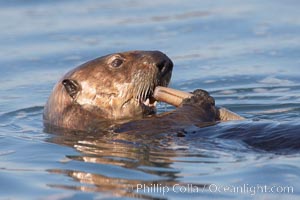
A sea otter eats a clam that it has taken from the shallow sandy bottom of Elkhorn Slough. Because sea otters have such a high metabolic rate, they eat up to 30% of their body weight each day in the form of clams, mussels, urchins, crabs and abalone. Sea otters are the only known tool-using marine mammal, using a stone or old shell to open the shells of their prey as they float on their backs.
Species: Sea otter, Enhydra lutris
Location: Elkhorn Slough National Estuarine Research Reserve, Moss Landing, California
Image ID: 21640
Species: Sea otter, Enhydra lutris
Location: Elkhorn Slough National Estuarine Research Reserve, Moss Landing, California
Image ID: 21640
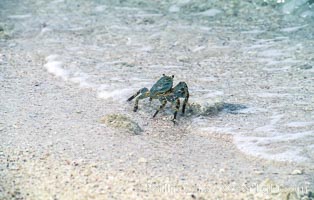
Crab on Sand at Rose Atoll NWR, American Samoa.
Location: Rose Atoll National Wildlife Refuge, American Samoa
Image ID: 00835
Location: Rose Atoll National Wildlife Refuge, American Samoa
Image ID: 00835
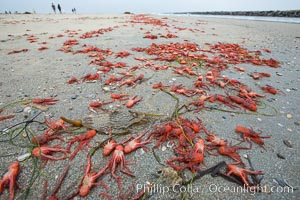
Pelagic red tuna crabs, washed ashore to form dense piles on the beach.
Species: Pelagic red crab, Pleuroncodes planipes
Location: Ocean Beach, California
Image ID: 30980
Species: Pelagic red crab, Pleuroncodes planipes
Location: Ocean Beach, California
Image ID: 30980
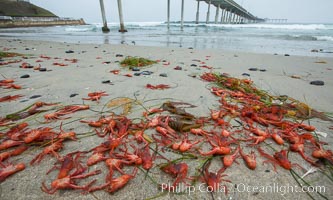
Pelagic red tuna crabs, washed ashore to form dense piles on the beach.
Species: Pelagic red crab, Pleuroncodes planipes
Location: Ocean Beach, California
Image ID: 30981
Species: Pelagic red crab, Pleuroncodes planipes
Location: Ocean Beach, California
Image ID: 30981
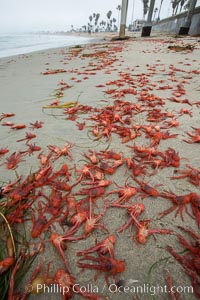
Pelagic red tuna crabs, washed ashore to form dense piles on the beach.
Species: Pelagic red crab, Pleuroncodes planipes
Location: Ocean Beach, California
Image ID: 30983
Species: Pelagic red crab, Pleuroncodes planipes
Location: Ocean Beach, California
Image ID: 30983
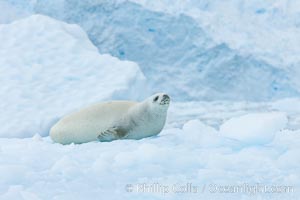
A crabeater seal, hauled out on pack ice to rest. Crabeater seals reach 2m and 200kg in size, with females being slightly larger than males. Crabeaters are the most abundant species of seal in the world, with as many as 75 million individuals. Despite its name, 80% the crabeater seal's diet consists of Antarctic krill. They have specially adapted teeth to strain the small krill from the water.
Species: Crabeater seal, Lobodon carcinophagus
Location: Cierva Cove, Antarctic Peninsula, Antarctica
Image ID: 25525
Species: Crabeater seal, Lobodon carcinophagus
Location: Cierva Cove, Antarctic Peninsula, Antarctica
Image ID: 25525
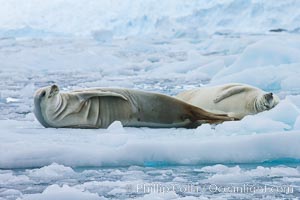
Crabeater seal resting on pack ice. Crabeater seals reach 2m and 200kg in size, with females being slightly larger than males. Crabeaters are the most abundant species of seal in the world, with as many as 75 million individuals. Despite its name, 80% the crabeater seal's diet consists of Antarctic krill. They have specially adapted teeth to strain the small krill from the water.
Species: Crabeater seal, Lobodon carcinophagus
Location: Cierva Cove, Antarctic Peninsula, Antarctica
Image ID: 25530
Species: Crabeater seal, Lobodon carcinophagus
Location: Cierva Cove, Antarctic Peninsula, Antarctica
Image ID: 25530
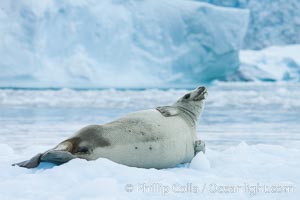
A crabeater seal, hauled out on pack ice to rest. Crabeater seals reach 2m and 200kg in size, with females being slightly larger than males. Crabeaters are the most abundant species of seal in the world, with as many as 75 million individuals. Despite its name, 80% the crabeater seal's diet consists of Antarctic krill. They have specially adapted teeth to strain the small krill from the water.
Species: Crabeater seal, Lobodon carcinophagus
Location: Cierva Cove, Antarctic Peninsula, Antarctica
Image ID: 25577
Species: Crabeater seal, Lobodon carcinophagus
Location: Cierva Cove, Antarctic Peninsula, Antarctica
Image ID: 25577
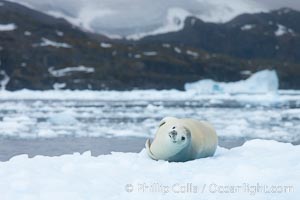
Crabeater seal resting on pack ice. Crabeater seals reach 2m and 200kg in size, with females being slightly larger than males. Crabeaters are the most abundant species of seal in the world, with as many as 75 million individuals. Despite its name, 80% the crabeater seal's diet consists of Antarctic krill. They have specially adapted teeth to strain the small krill from the water.
Species: Crabeater seal, Lobodon carcinophagus
Location: Cierva Cove, Antarctic Peninsula, Antarctica
Image ID: 25579
Species: Crabeater seal, Lobodon carcinophagus
Location: Cierva Cove, Antarctic Peninsula, Antarctica
Image ID: 25579
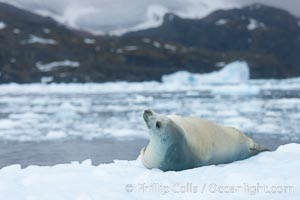
Crabeater seal resting on pack ice. Crabeater seals reach 2m and 200kg in size, with females being slightly larger than males. Crabeaters are the most abundant species of seal in the world, with as many as 75 million individuals. Despite its name, 80% the crabeater seal's diet consists of Antarctic krill. They have specially adapted teeth to strain the small krill from the water.
Species: Crabeater seal, Lobodon carcinophagus
Location: Cierva Cove, Antarctic Peninsula, Antarctica
Image ID: 25580
Species: Crabeater seal, Lobodon carcinophagus
Location: Cierva Cove, Antarctic Peninsula, Antarctica
Image ID: 25580
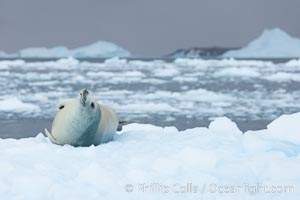
Crabeater seal resting on pack ice. Crabeater seals reach 2m and 200kg in size, with females being slightly larger than males. Crabeaters are the most abundant species of seal in the world, with as many as 75 million individuals. Despite its name, 80% the crabeater seal's diet consists of Antarctic krill. They have specially adapted teeth to strain the small krill from the water.
Species: Crabeater seal, Lobodon carcinophagus
Location: Cierva Cove, Antarctic Peninsula, Antarctica
Image ID: 25581
Species: Crabeater seal, Lobodon carcinophagus
Location: Cierva Cove, Antarctic Peninsula, Antarctica
Image ID: 25581
